I made an Elizabethan ruff! And it turned out really well (not perfect, but really well). And I am extremely pleased with myself.
And it’s really, really close to perfectly historically accurate!
Making a ruff turned out to be a lot harder than I thought it would be simply because there is so much rubbish information about ruffs on the internet. (Granted, there is rubbish information in books too – Tudor Tailor doesn’t do a good job of making it clear when they are using a historically accurate method and when they use a theatre one, for example, and even Saint Janet got things wrong on occasion. So I like to read EVERYTHING and then collate all the evidence in the hopes of arriving at something at least reasonably plausible.)
So I had to weed out all the advice about 1) cutting yourself a really long strip entirely on the selvedge (this immediately read wrong to me because it’s hugely wasteful of fabric, and fabric wastage is rarely historically accurate. Plus the grain will be wrong and the ruff will want to collapse if you have the grain running along it rather than across it. And yep, when I looked into it every example of an extant ruff I could find is cut from multiple lengths across the grain); 2) arranging your ruff into stacked pleats (doesn’t match the visual evidence, extant ruffs, or written historical records), 3) using fishing line on the edges (clearly this isn’t HA), 4) sewing your setts into place (useful for theatre, but not supported by any historical record)
I ended up relying almost entirely on Arnold and Noel Gielgehem’s extremely helpful 1570s ruff tutorial/discussion at St George North.
I made one-and-a-half huge concessions to historical accuracy in making my ruff.
The big one was finishing the raw edge and attaching the lace by machine – I wasn’t willing to expend the amount of time it takes to hand sew 162″ of hem on a ruff I wasn’t sure would work out.
The smaller concession was fabric: I used a vintage linen intended for napkins, with helpful drawn threads at intervals, for my ruff. It’s a lower grade than would have been used in an Elizabethan ruff (not that it’s really even possible to find linen up to Elizabethan standards), and, of course, the drawn thread gaps aren’t accurate, but it’s not too bad, and it was cheap ($3 for a couple of meteres at an op-shop!), so great for what is effectively a working toile.
I joined my lengths of linen, finished my edges, attached my lace (with help from the lovely Nina of Smash the Stash, who rescued me from a couple of hours of, if not exactly swearing, at least emphatic grumbling, by doing it for me), and then marked the points for cartridge pleating.
And marked them.
And marked them.
And marked them.
And marked them.
1,296 cartridge pleat points later (and I did the MINIMUM number of lines!) I was ready to cartridge pleat, which, of course, took every bit as long as marking the dots.
But I’ll spare you the repeated blog points of them.
I gathered in the cartridge pleating, and attached them to my neckband, added ties, and I had a ruff:
I managed to twist and warp the neckband a little bit while making it. I may re-do that at some point, depending on how soon I am motivated to make a better one.
Once the ruff was done, I washed it:
And made starch, and coated it in starching paste:
This is where I made the biggest mistake of the process. I let the ruff dry on a wooden chopping block. Bad move. I hope the wood stains launder out!
As it dried, I shaped the setts, and once it was almost dry, I used a curling iron to finish setting them. My setts certainly aren’t perfect, and I mis-measured on one end, but for my very first attempt, not too bad!
Here is the mis-measuring:
The starching is REALLY impressive. The ruff is STIFF. These photographs were taken after the ruff had already spent a day being handed around and inspected by 60+ 14 year old girls, and modelled by four of them.
 And it was a warm, extremely humid day. But there is no wilting whatsoever!
And it was a warm, extremely humid day. But there is no wilting whatsoever!
I think I see more ruffs in my future…
The Challenge: #12: Re-Do
Challenges this is re-doing (once again, I am attempting to re-do every challenge from the year in December, though each item can cover multiple challeges):
– #3 Stashbusting: I’ve had the linen and lace in stash for years)
– #4 War & Peace: unprecedented peace within Tudor & Elizabethan England brought prosperity, and enough abundance to use wheat starch on clothing, rather than just as food.
– #6 Out of Your Comfort Zone: I’ve never made a ruff, worked with starch from scratch, or done upper-class Elizabethan.
– #7 Accessorise: that one should be self evident
– #8 Heirlooms & Heritage: some of my ancestors were minor nobility in England at this period, shortly before they emigrated to the US (pre-Mayflower!), this is exactly the sort of garment they would have worn, and another one was apparently a linen weaver in Wales, who may have made linen for ruffs.
– #11 Silver Screen: there are dozens of films about Queen Elizabeth or Shakespeare that use ruffs like this, but mine particularly reminds me of the ruffs in Shakespear in Love – one of the things the films costuming really got right was the not-always-pristine-ness of the ruffs, which lent an air of authenticity even if the costumes weren’t technically accurate.
Fabric: 1/2 metre of ivory linen
Pattern: None, but hugely based on this tutorial, with lots of reference to Janet Arnold
Year: ca. 1570
Notions: linen thread, cotton lace, cotton thread
How historically accurate is it?: I finished the ruff edges with machine sewing, and the lace is (of course) modern, and the overall construction is a bit rough, but it’s not at all implausible than a (possibly slightly inept) 15th c apprentice ruff-maker made something very like this as their first attempt! Overall, I’m quite pleased. 80%
Hours to complete: 12
First worn: Wed Dec 2nd, by a bunch of high school girls who I gave a talk on Elizabethan fashion to. The photos shows the ruff post handling, inspection & try-ons by 60+ 14-year-olds, so I think it’s holding up pretty well indeed!
Total cost: Under $5

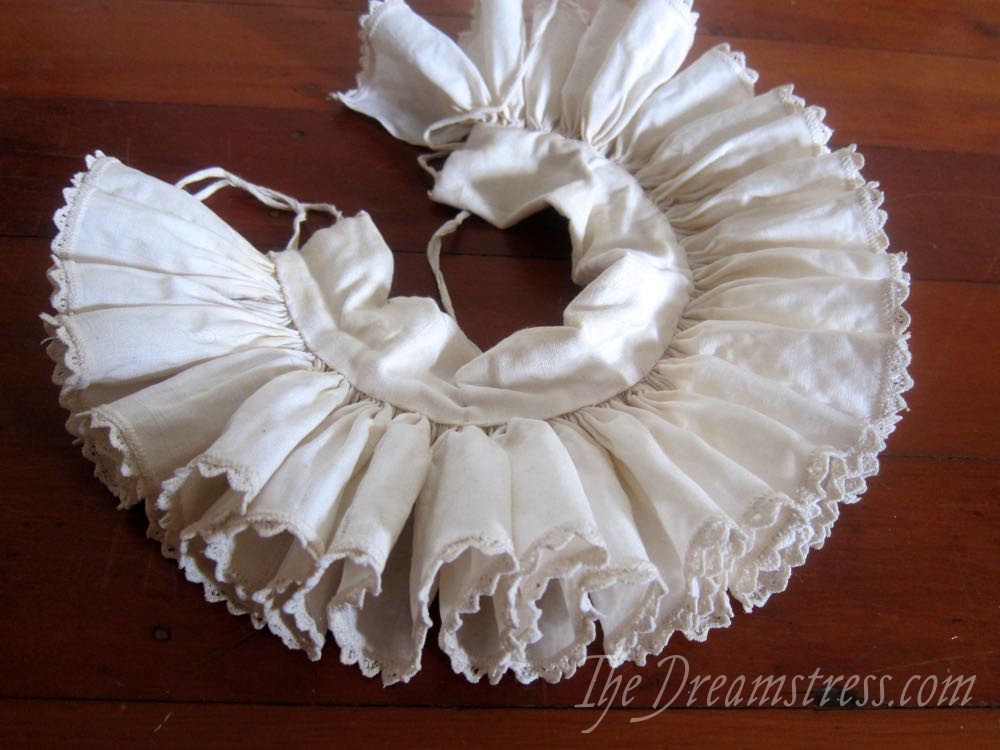
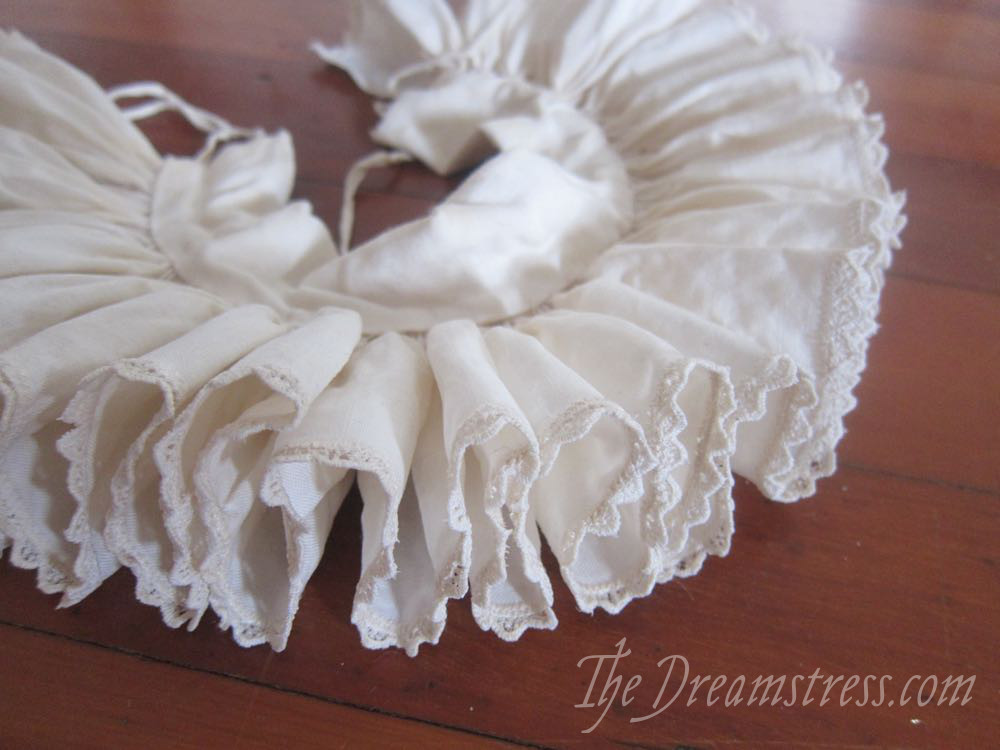


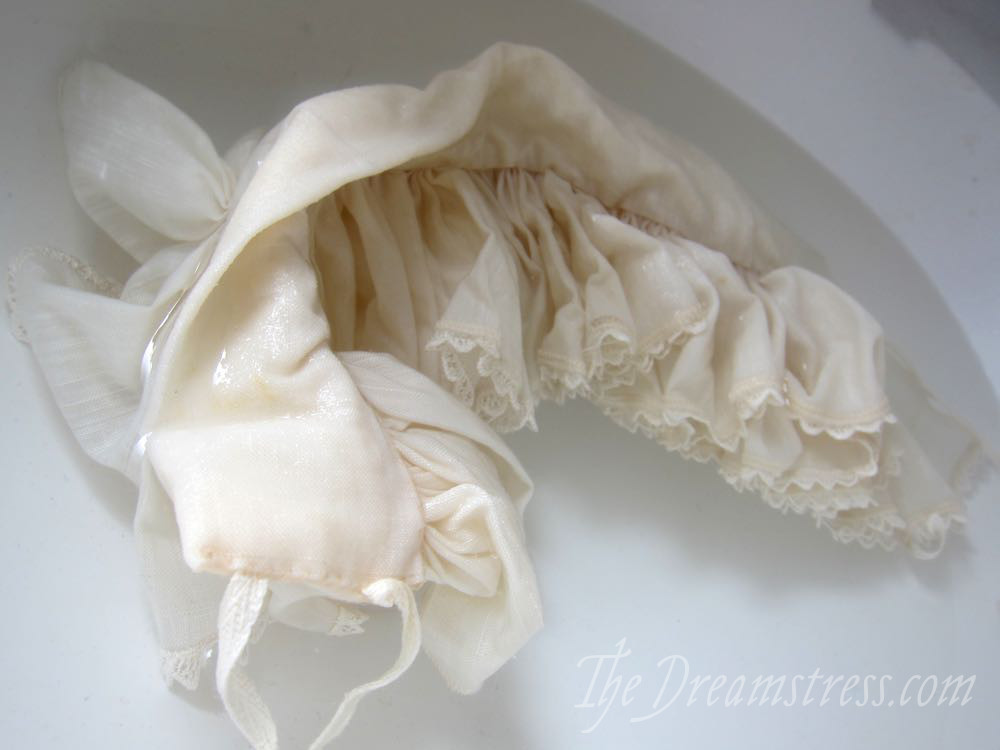
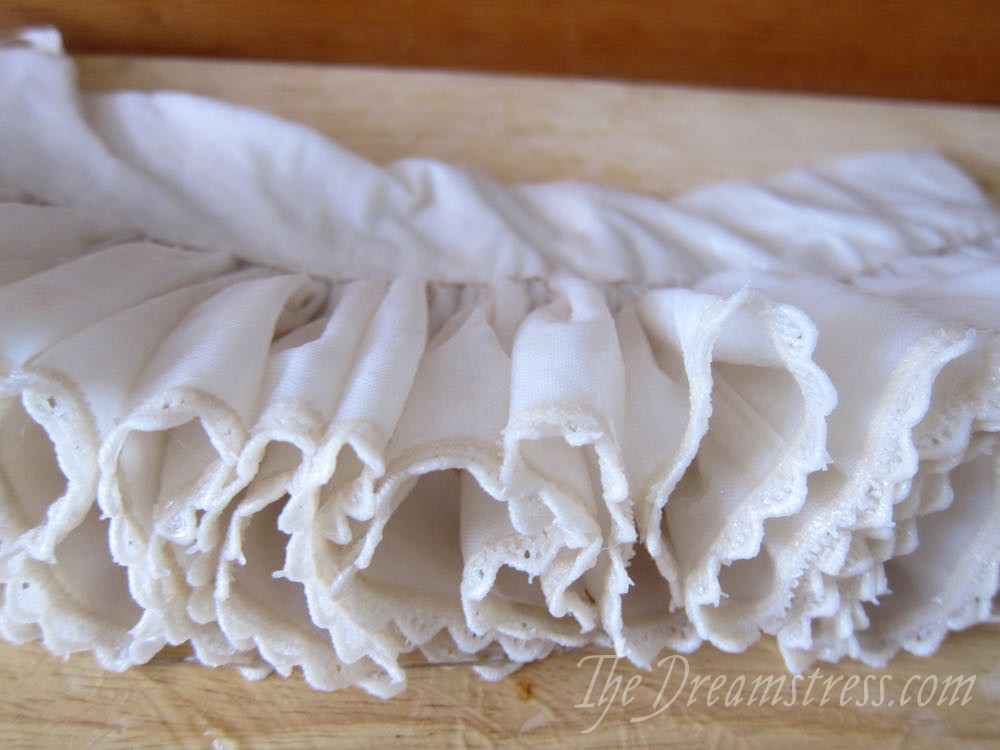
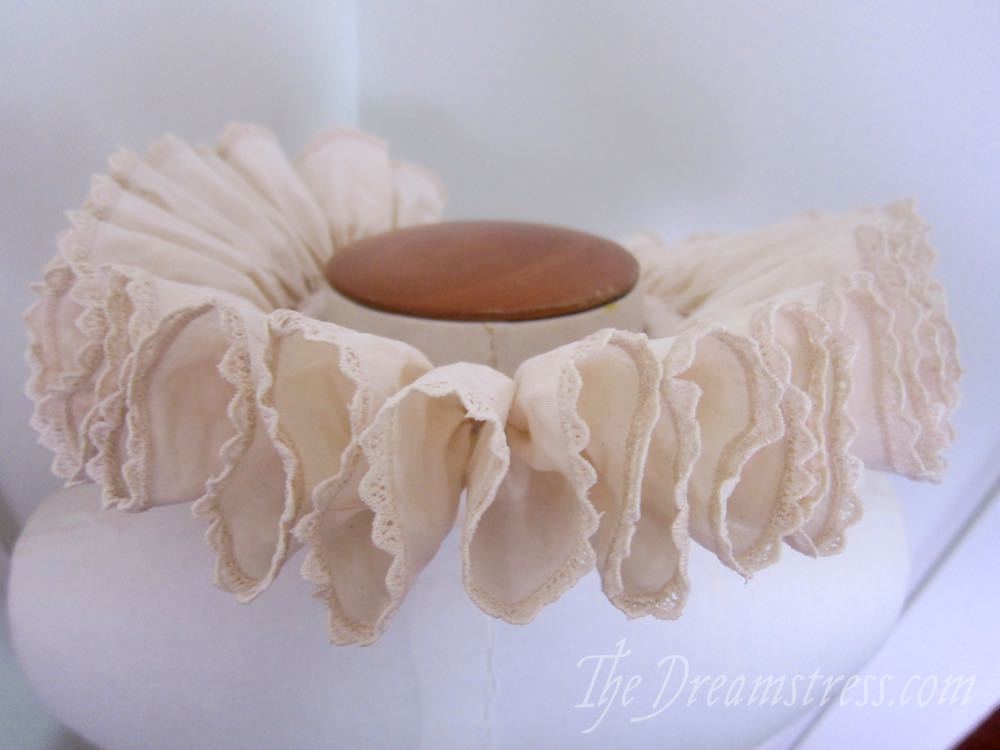
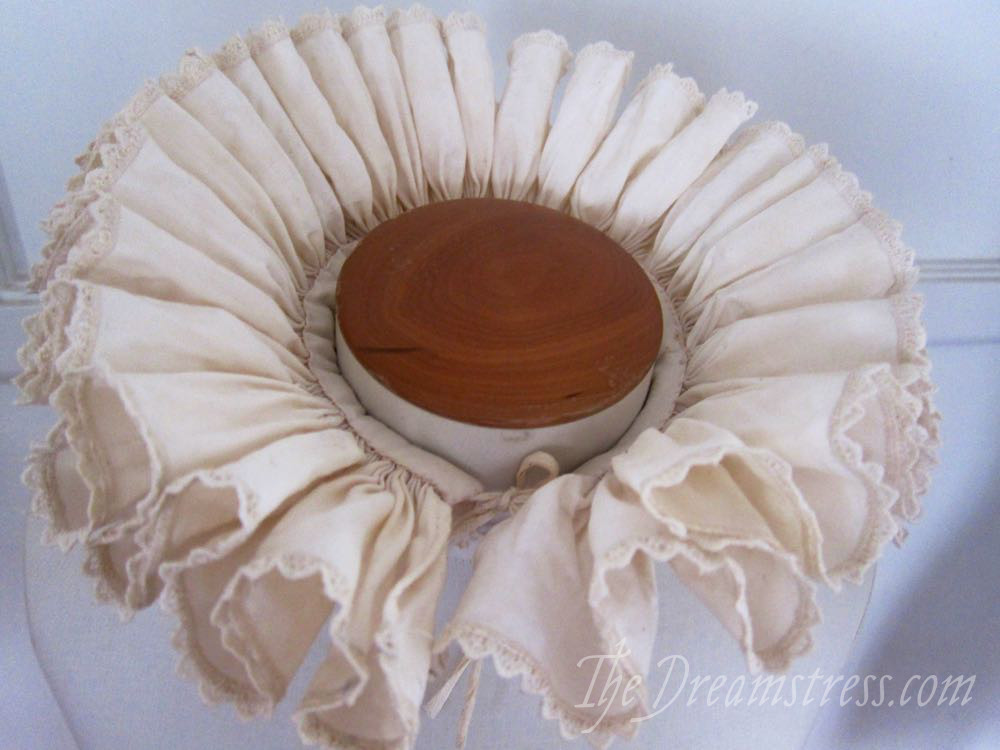
If there are more ruffs in your future, then I would love to see some really in-depth construction photos!
Very impressive! (and I can’t believe you actually counted the pleat points!!!)
It looks amazing, and I would love to learn more on how it’s done. I am new to all historical sewing, and if researching anything, I wouldn’t know where to start or how to sort the good info from the bad. Us newbs are so naive, we believe in anything 😀
sdilna.wz.czWhoa to the pleat points – marking AND counting them. I’ve just done cartridge pleating myself with the apron I’ve made for Silver Screen, but I wasn’t as thorough as that. 😀 And I’m fairly sure it was less in my case. How far apart did you mark them, by the way?
I’m now comparing it to one of the folk costume ones I mentioned – interestingly, that one has the neckband form a flat-lying slit neckline rather than a circle. And now I notice that it goes under the ruffle – perfectly logical, but it’s something you never think of until you have opportunity to think of it.
Here, scroll down a bit for the comparison:
http://www.sdilna.wz.cz/soucastkya.html
(The neckband goes under the ruffle in the historical ruff, is what I meant.)
That was what I noticed for the first time ever too – that neckband under the ruffle. I don’t think I’ve ever seen a ruff “off” before, so I had no idea how it was actually constructed to interact with the neck it was on. Fascinating!
Wow! It’s wonderful!
I’ve wanted to find out how they were made for some tome now. I’d never noticed the colllar that the ruff is attached to before….
Fascinating!
Impressive! This article has an interesting tip for marking cartridge pleats: http://thelacedangel.blogspot.com/2014/07/quick-and-easy-way-to-mark-cartridge.html. Use your sewing machine with a double needle that isn’t threaded. Only works if needle marks show on your fabric, though.
That is a great tip, but needle marks didn’t show up reliably in this fabric. I usually mark cartridge pleats like this with smocking transfers, but didn’t have any to hand this time.
It is fantastic and beautiful and looks like a real garment made for a real person, which so many ruffs don’t. Love it!What did you use to starch it in the end? I mean, was it a branded starch product, or arrowroot or cornflour or some such?
It does really look ‘real’ doesn’t it! I think the thing I’ve really not liked about ruffs is that so many of them look so sterile and too perfect, and it’s really turned me off.
I ended up using cornstarch, simply because I inexplicably have three boxes of it in my cupboard. It will take a lot of ruffs to use them up!
It’s truly beautiful. I made a cheats one donkey’s years ago and I remember the headaches it gave me. I can’t now recall the mechanics of it but I think I attached it to some belt stiffening which made it sit firmly around the neck. I’m going to try another one and do it properly like yours. I hope it turns out as stunning as your. Thanks for the inspiration.
Thank you! I was really impressed by how hard it actually wasn’t to make it. I think the cheats one may sometimes be false economising. You think it’s easier, but you just end up doing more work!
Looks tedious (even with machine), but simple. I can imagine that this would be the perfect project to do while talking with a friend, or though meditation. I also like the realness, and the connection to family. Well done!
As a child I drew the repetitive figure 8 design constantly. My great grandmother told me the design was called the “Lemnacati”. I’ve only seen this design on a Ruff. I’m trying to research but the word “Lemnacati” doesn’t seem to exist. In your studies did you come across any info on the history or inspiration or meaning of the repeated figure 8 that apparently inspired the Ruff?